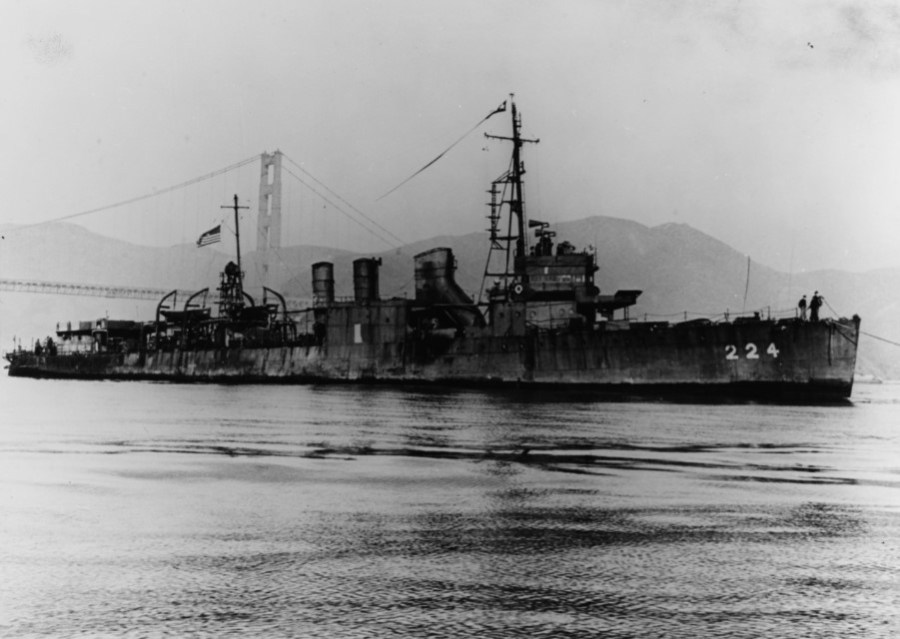A surviving ship from WWII that was used by both Allied and Axis forces in the Pacific and that was given a ceremonial burial at sea has finally been located after more than seven decades underwater.
Thirty miles off the coast of California, resting on the seafloor of the Cordell Bank National Marine Sanctuary, resides USS Stewart DD-224.
An expedition group composed of government and private organizations discovered the long-lost WWII destroyer on Aug. 1, using underwater drones operated by Ocean Infinity.
“The USS Stewart represents a unique opportunity to study a well-preserved example of early twentieth-century destroyer design,” said Dr. James Delgado of SEARCH. “Its story, from US Navy service to Japanese capture and back again, makes it a powerful symbol of the Pacific War’s complexity.”
Current State of USS Stewart
Sonar scans from the drones found the Stewart remains mostly intact and that its hull remains mostly upright on the seafloor.
“This level of preservation is exceptional for a vessel of its age and makes it potentially one of the best-preserved examples of a US Navy “fourstacker” destroyer known to exist,” SEARCH wrote in a news release.
History of USS Stewart DD-224
Laid in 1919 and commissioned in Sept. 1920, the Stewart would miss WWI by nearly two years and be left to await a future conflict.
After serving in the Atlantic Fleet during its first two years of service, the Stewart was repositioned to the Asiatic Fleet on June 20, 1922, after traveling through the Mediterranean Sea to the Indian Ocean and onto the Phillippines.
Naval History and Heritage Command photograph
For 23 years, the Stewart would not return to the United States as she patrolled the Chinese coast, Philippines and other US territorial interests at the time.
In November 1941, the Stewart was among several ships of the Asiatic Fleet that were pulled from China after the fleet received a war warning from Chief Naval Operations.
On Feb. 14, 1942, the Stewart and its crew set out for their first major sea battle along the northern coast of Sumatra as they looked to engage advancing Japanese ships.
However, a Dutch ship that had run aground in the Stewart’s path forced the ship to back up its engines. On Feb. 15, the Stewart survived several aerial bombardments from the Japanese.
On Feb. 19, the Stewart made direct contact with the Japanese fleet as the remainder of the Asiatic Fleet pushed for a night attack in what would be come to known as the Battle of Badung Strait.
The Stewart was blasted by Japanese destroyers, losing its boats and torpedo tubes and having an impacting shell tear open the ship’s seams, flooding its steering engine room.
The engine would remain running, allowing the Stewart to return to Surabaya on the morning of Feb. 20, 1942.
Arriving with severe damage and sustaining further damage in docking, detonation charges were exploded in the ship and a Japanese bomb struck the Stewart as its crew abandoned it on Feb. 22.
After taking the island and discovering the damaged destroyer in the drydock, Japanese forces refloated the ship, repaired it, and commissioned it in February 1943 as Patrol Boat No. 102.
The Stewart would serve with the Japanese Navy for the remainder of the war and serve as an odd sight to Allied pilots as they spotted the destroyer operating deep behind enemy lines.
Following the Japanese surrender, the Stewart was found by American occupying forces laid up in Hiro Bay near Kure, Japan.
On Oct. 29, 1945, the Stewart was recommissioned DD-224 in Kure and was nicknamed RAMP-224 standing for “Recovered Allied Military Personnel.”
In March 1946, the Stewart arrived in San Francisco after being towed from Guam, where its engines had failed.
In a ceremonial “burial at sea”, the Stewart was used as target practice on May 24, 1946 for Navy aircraft and vessels that fired rockets and machine guns at the decommissioned vessel for two hours.
It took twelve 40-mm and 17 three-inch shells from USS PC-799 to finally send the USS Stewart to the bottom of the Pacific.

